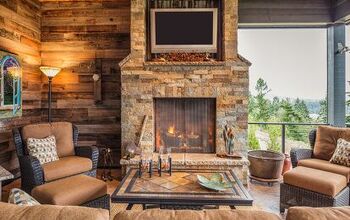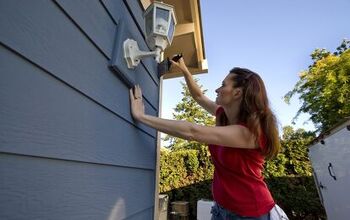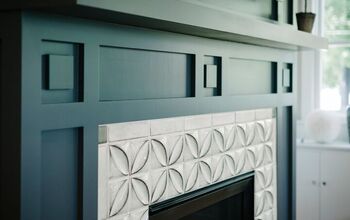Can You Paint A Sandstone Fireplace?

Having a functional sandstone fireplace is a great way to lower your winter energy costs. It also promotes a wonderful cozy energy in your home in the cooler months. There really is nothing quite like it. Unfortunately, some fireplaces can look a bit dated over time. What might have once been stylish might now appear shabby or out of vogue. This might have you wondering if you can actually paint your sandstone fireplace and give it a new look.
When you paint a sandstone fireplace, you should first thoroughly clean the surface and caulk any large cracks. Use a layer of acrylic latex primer to ensure even coverage and to help the paint stick. Choose a latex, chalk, or acrylic stucco paint to cover your sandstone fireplace, and paint at least two layers. Use a bristled paint brush to reach the small holes and crevices found on sandstone surfaces.
Painting your sandstone fireplace is not only possible, but it is also fairly straightforward. It is, however, you follow several standard preparation and painting steps. Properly preparing and staging your sandstone fireplace painting project will help you yield clean and professional-looking results.
How To Prepare Your Sandstone Fireplace For Painting
1. Remove Everything From Fireplace Area
The first step you need to take to prepare your sandstone fireplace for painting is to remove anything on or near the fireplace. If you have any shelving, carefully remove it. Also be sure to remove the screen and any fireplace accessories, to ensure no paint is spilled on them.
2. Place Drop Clothes and Painters Tape Around Paint Area
Place tarps or drop cloths on the floor surrounding the fireplace. This will provide you with a safe workspace, and will help prevent paint from dripping on your floors or carpet.
Also, use painters tape along the borders of your paint area. This will allow you the ability to work the edges of the sandstone fireplace without worrying about getting paint on the wall.
3. Wipe Surfaces Thoroughly
Make sure you clean and wipe the sandstone thoroughly. Use a clean brush to get into any holes that are hard to reach spots, as many sandstone fireplaces have tiny holes that rags can’t reach. Use a damp cloth to ensure all dust and dirt is removed from the surface.
4. Inspect Area For Cracks Or Damage
Once the area is cleaned and wiped you can easily spot imperfections. Look for any cracks or signs of deterioration. If there are any sizable gaps or cracks, you should fill them with an acrylic latex caulk. This ensures the problem does not worsen.
5. Allow Area To Dry
You want to make sure the sandstone (and any caulk) is completely dry before you begin the painting process. If you can afford to wait, it is best to let the area dry for a full day. A climate-controlled and well-ventilated room can greatly reduce the amount of time needed for the sandstone fireplace to dry.
The Best Paint and Materials To Use To Paint Stone Fireplaces
Do I Need A Primer?
You should use a primer when painting your sandstone fireplace. Stone is not always the easiest material to adhere paint to. Starting with a layer of primer will greatly improve how well your paint sticks to the stone fireplace. Sandstone is also often several shades. A layer of primer helps mute these colors. It allows you to easily achieve one final color in the end, rather than visible inconsistencies.
What Type Of Paint Do I Need For My Sandstone Fireplace?
While there are many paint types to choose from, the most popular types are chalk paint, acrylic stucco paint and latex paint. While these options are suitable, if you plan to paint your fireplace lighter than the stone itself (which is quite common), you should use latex paint.
Latex paint is quite durable, which is important when choosing a paint to put on stone and near a fireplace. It is also more adhesive, which makes it a great option for painting on stone, which is a less conventional surface. Lastly, it is fairly resistant to fading, which means it is likely to last longer than other paint types.
Pro Tip: Acrylic latex primer works best with latex paint. This is the best combination of paint when you plan to paint the fireplace a lighter color than the sandstone itself.
Brushes vs. Roller vs. Paint Sprayer
Paint rollers can be time savers for many projects, but they are not a good tool to use when you paint a sandstone fireplace. Sandstone has lots of small nooks and crevices, which paint rollers can not reach.
A paint sprayer is an option, but because of the nature of the nooks and cracks, you might have to approach from multiple angles in order to have a thorough and even paint job. Paint sprayers also run the risk of getting over parts of your walls and floors. They are rarely used inside, and would require a great deal more preparation work.
For painting sandstone, a good old fashion paint brush is the way to go. You can paint in all directions, and use the bristles to get into the small holes and awkward areas easily.
Steps By Step Guide To Painting Your Sandstone Fireplace
Step One: Add Layer Of Primer
Make sure you do not skip the primer step. Adding a layer of primer ensures an even finished product, even if your sandstone fireplace has multiple tones and textures. Additionally, primer is a great way to ensure your paint sticks to the sandstone easily. For best results, carefully work your way from the top to the bottom. Take your time to make sure all small holes and areas receive a layer of primer. Check your primer can for instructions on how long you need to allow your primer to dry.
Tip: For best drying results, use fans in a well-ventilated room. This promotes the drying process.
Step Two: Apply First Layer of Paint
Once you have allowed the primer ample time to dry, you are ready to apply your first layer of paint. Just like with the primer layer, work your way from the top to the bottom for the most even results. Take your time, and use the bristles of the brush to get in those hard to reach crevices. Once you have evenly painted your first layer of paint, allow the proper amount of time for it to dry (as dictated by your paint label).
Step Three: Second Layer Of Paint
Once the first coat of paint has dried, inspect the surface and note any areas that are not even, or perhaps lack a bit of coverage. Make sure you get these areas thoroughly to make sure you will not need a third coat. Once you complete the second coat, you can opt to use your paint roller to smooth out the final coat. This can help even things out and make the paint layer thin and even.
Step Five: Drying And Cleanup
Make sure you allow plenty of time for your paint to dry. Make sure all areas are covered evenly before putting away the paint and project materials. Once you decide you are happy with the results, you can begin to remove the drop cloths and tape you used to protect your surfaces.
Pro Tip: Pull off the painters tape when your paint is half-dry. This will prevent paint from dripping on the wall and also keep the dry paint from cracking.
Wrapping Up How To Paint Your Sandstone Fireplace
Remember that before you paint your sandstone fireplace you first need to clean it and wipe it down. Don’t go right into painting it. First make sure you tape the borders and lay drop cloths to prevent any unnecessary spilling. Paint at least one layer of primer before you paint two layers of paint. Once the work is dry and you are satisfied with your results, clean up the mess and enjoy your new fireplace look for years to come.

Tom Gaffey is an expert writer who currently resides in Washington D.C. Tom has a passion for real estate and home improvement writing, as well as travel and lifestyle writing. He lived the last twelve years in Hawaii where he worked closely with luxury resorts and event planners, mastering his knowledge of aesthetics and luxury products. This is where he found his passion for home improvement and a keen interest in DIY projects. Currently, Tom resides in Washington D.C, and also working on his debut fiction novel.
More by Tom Gaffey



























